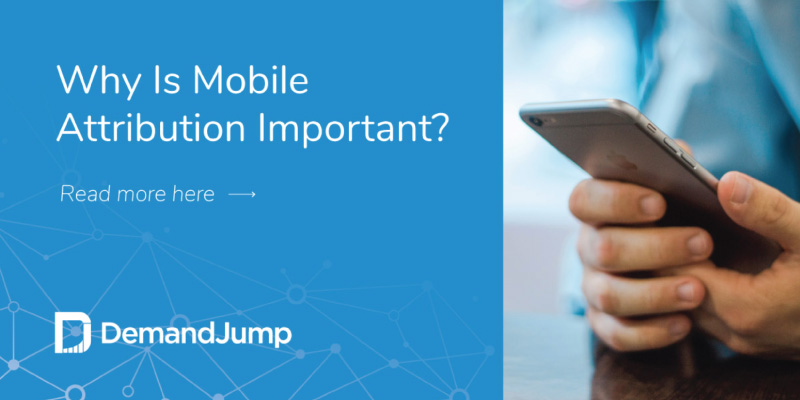Why Is Mobile Attribution Important?
May 29, 2020 •DJ Team

Multi-touch attribution platforms must account for the many mobile devices and apps used by today’s digital consumers. Tracking the customer journey from initial interaction across multiple touchpoints on various mobile channels allows marketers to determine a campaign’s ROI, improve customer interactions and, as a result, grow revenue through better investments.
Marketers think of marketing attribution in terms of tracking engagement on web browsers and mobile devices. But the desire to connect an outcome to preceding events goes beyond technology. Social psychologists in the field of attribution theory view this behavior as deeply human.
What’s also human are the many errors that often accompany our explanations of causes and effects. People sometimes attribute events to situational rather than dispositional circumstances, or vice-versa, and see relationships where none exist. Without sufficient data and careful analysis, we all make misjudgments and miss opportunities.
Marketers are no exception. Many implement some form of attribution in their digital marketing strategies. But because attribution platforms often don’t take mobile activity into account, or measure it ineffectively, they often fall short.
What Is Mobile App Tracking in Web Attribution?
Mobile attribution leverages the benefits of multi-touch models across the array of devices and apps consumers use today.
As mobile continues to grow, missing key touchpoints along the sales funnel due to poor tracking and measurement becomes a greater problem. If you wonder what percentage of internet traffic mobile accounts for, the number averages slightly over 50%, but it will grow to roughly three-quarters of all online activity by 2025, according to CNBC. Although mobile use is on the rise, mobile attribution remains a puzzle for most.

“As any new technology or methodology, it can be difficult to implement and get buy-in from everyone involved in a company’s sales funnel,” points out an article in Forbes. “As change starts from the top, getting stakeholders’ approval and support is often crucial for a successful transition to MTA models.”
While executives might not be as enthused as their marketing cohorts about connecting an outcome to its precipitating events, they appreciate anything that improves the bottom line. Here are some ways mobile attribution, using a multi-touch attribution model, does exactly that.
What is An Attribution Model With Mobile Worth?
Of the several different attribution models developed over the years, multi-touch varieties provide the most accuracy. These account for all customer interactions with a brand leading up to a conversion, as well as after the sale. Multi-touch attribution can track these touchpoints using a variety of methods, including linear, position-based, time decay and data-driven models.
In their own ways, these models eliminate much of the guesswork for marketing departments. Modern martech tools strive to provide the exact number, type and quality of touches that led to a conversion, often weighting the various platforms. After all, placing value on touches across the customer journey is key.
“To find out what's working in your marketing and what's not, identify the role of each touchpoint along the customer's journey,” the marketing experts at Think With Google explain.
Advantages of Mobile Web Attribution
So why is mobile attribution so important? It provides several core benefits to marketing teams, allowing them to:
Prove a campaign’s effectiveness across the sales funnel and calculate ROI.
The rule of seven interactions potentially holds more importance in a mobile landscape, where consumers become distracted more easily during browsing. Multi-touch attribution that includes mobile shows the combination of platforms, creative and frequencies leading to conversions. It counts more than just the first click or the last, but every touchpoint across the customer’s journey.
Gauge and enhance customer interactions.
Finding the most effective means to communicate with potential or current customers on a granular, individual level provides another critical benefit: It makes customers happy to engage with your brand. Just as importantly, marketers can analyze the data from mobile attribution platforms to eliminate any broken links on the path to conversion or re-engagement.
Make better investments and increase revenue.
Marketing is too-often labeled a cost center, when the goal is to create new customers, cultivate existing clients and help generate sales. Investing in marketing strategies that work well at every point across the sales funnel enables marketers to increase their return on ad spend and cut inefficiencies.
As your cost to conversion decreases and customer satisfaction increases, the C-suite will be more willing to back mobile multi-touch attribution efforts. However, the diversity and complexity of mobile creates unique challenges for even the most-seasoned marketers. Consider partnering with an experienced data analytics firm to ensure accurate results and the best outcomes.
Want to reach key market segments, generate revenue and prove ROI in your marketing? Try DemandJump’s mobile attribution platform today - for free.
Featured Articles
Categories
- Attribution Tracking (13)
- Channel Optimization (11)
- Consumer Insights (68)
- Content Marketing (251)
- Data Science (8)
- Digital Marketing (6)
- Digital Transformation (26)
- Enterprise (10)
- Lead Generation (14)
- Market Intelligence (8)
- Marketing Analytics (39)
- Marketing Attribution (57)
- Marketing Management (153)
- Marketing Operations (86)
- Organic Search (222)
- Paid Search (52)
- Pillar-Based Marketing (63)
- Programmatic Advertising (9)
- SaaS Content (14)
- SaaS Marketing (29)
- Search Marketing (111)
- SEO Keyword Research (28)
- SEO Pillar (18)
- SEO Strategy (46)
- SMB (5)
- Website Content (12)


